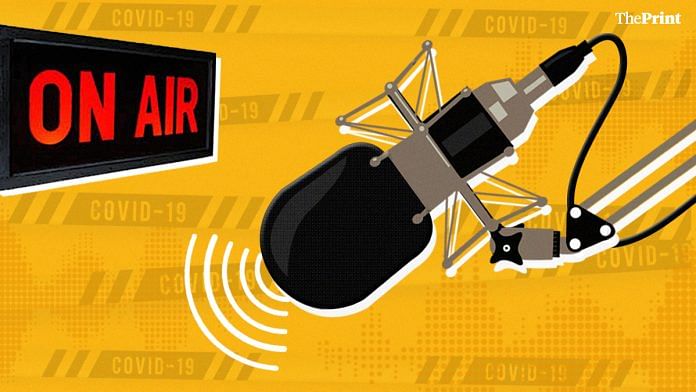New Delhi: The central government needs to create an “ecosystem” to help give a push to digital radio in India, a recent report by India Cellular and Electronics Association (ICEA) and Ernst & Young (EY) has said.
Titled ‘Digital broadcast radio in India — perspectives on the opportunity and requirements for successful implementation’, the report, released Thursday, drew comparisons with other countries and spoke about the need to boost digital radio in India for better revenue generation. It also said a transition from analog radio technology to digital radio requires capital investment and would take at least three to five years.
One of the main forecasts of the report by ICEA, an industry body for mobile and electronics, and EY, one of the ‘Big Four’ accounting firms in the world, was that the broadcast sector could double its revenues within five years to Rs 123 billion.
Apurva Chandra, Secretary, Ministry of Information and Broadcasting, said the central government was making efforts to remove “regulatory hindrances” on the path of boosting the digital radio technology in India.
First introduced in India in 2007, digital radio is a technology that, unlike AM and FM, uses digital signals to send information. The technology processes sound in the pattern of numbers or “digits”, as opposed to electrical signals resembling soundwaves, like in traditional analog radio.
The central government has, so far, had two trials for the Digital Radio Mondiale (DRM) technology — one in 2007 and the other in 2021.
The DRM is an openly standardised digital broadcasting system for all broadcasting frequencies. The technology requires only an upgrade of the existing transmitter infrastructure to transform it into digital radio.
At the moment, only the state-owned All India Radio (AIR) is equipped to use DRM technology.
Private players in the radio industry say they haven’t been consulted on the government’s plans to push digital radio.
The ICEA and EY report comes four years after the Telecom Regulatory Authority of India (TRAI), the country’s telecom watchdog, had highlighted the “lack of ecosystem for digital radio broadcasting in India”.
TRAI in its report had said that it wouldn’t be possible to develop the required ecosystem for digital radio broadcasting “unless a clear policy framework was defined and unified efforts were made”. It had also said that India’s private radio industry should be allowed to provide digital radio broadcasting services.
Despite many deliberations, however, the government is yet to draw up a comprehensive framework for digital radio in India, the report by ICEA and EY pointed out.
Also Read: Run ‘public interest’ announcements for 1 hr daily or face penalty — Modi govt tells pvt radio
‘Smartphones will play a crucial role’
Aimed at analysing India’s DRM market and comparing it to other countries of the world, the report says that India’s current digital radio infrastructure allows for content to be transferred for only three hours a day — and that too just in 29 Indian cities — using the DRM technology.
It adds that India’s current DRM infrastructure “has been impacted by a lack of consumer receivers, no clear and affordable product roadmap or mobile phone integration” even though HD Radio was tested in Dhanbad in 2007.
HD Radio is a digital radio that generally broadcasts an existing analog radio station in a digital format with less noise and additional text information.
According to the report, smartphones will play a crucial role in ensuring digital radio access on all mobile phones. This, the report said, could be done by inserting chipsets into mobile phones to enable ‘direct-to-mobile’ transmission.
“Currently in India, both the DRM and the HD Radio technologies are being evaluated for better feasibility considering the highly fragmented radio listenership,” the report said. “AIR is in an advanced stage of testing both digital radio broadcast options for FM channels and a standard is expected to be announced soon to start the rollout of digital FM radio in India,” the report said.
‘Formal policy needed’
The report highlighted several challenges that stand in the way of boosting digital radio coverage in India — one being integrating chipsets “and/or antenna to receive digital broadcast radio” on mobile phones.
“There is no doubt that this process will take some time but we are trying our best to bring in private players who could make these chips,” Chandra told ThePrint. “We also had successful 5G auctions and there are discussions on how that infrastructure could be used for different sectors, including radio. The next three to four months will be crucial.”
Private players meanwhile complain that the industry has been largely ignored in the consultation process surrounding digital radio.
“I don’t think there’s a serious intention of discussing these policy aspects with us,” said Uday Chawla, secretary general of the Association of Radio Operators in India, the industry body representing India’s commercial radio stations, to ThePrint. “Even when it comes to content, there are circulars about what should and shouldn’t be disseminated but no one [has] consulted us in any process”.
Another factor is the investment required for the transition from analog to digital radio.
“Transitioning to digital radio requires capital investment,” the report says. “The FDI (foreign direct investment) currently allowed in the Indian radio segment is just 49 per cent, making it difficult for players to raise capital to compete with digital products.”
The current fall in radio revenues and the industry’s general inability to measure radio listenership accurately and at scale could “dampen the investment appetite in the near term”, the report added.
Moreover, in order to sustain revenue, companies will have to rely on both analog and digital signals, it said.
“The Government needs to prepare a formal policy that defines the approach to be adopted for the transition, the roadmap to be followed, and the timelines for the transition, keeping in mind the issues faced by various stakeholders,” the report said.
(Edited by Uttara Ramaswamy)
Also Read: How FM Radio spread positivity and created a sense of community during the lockdown



